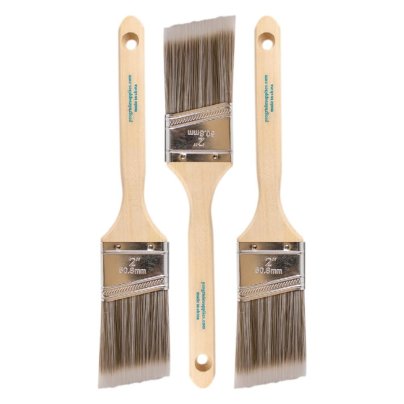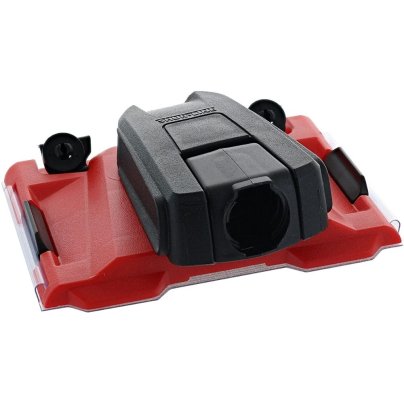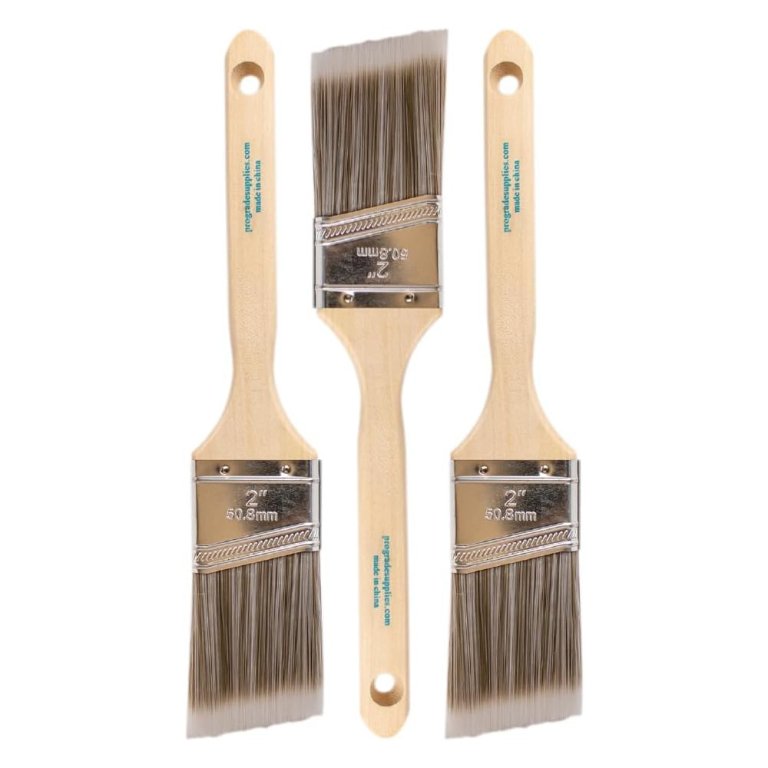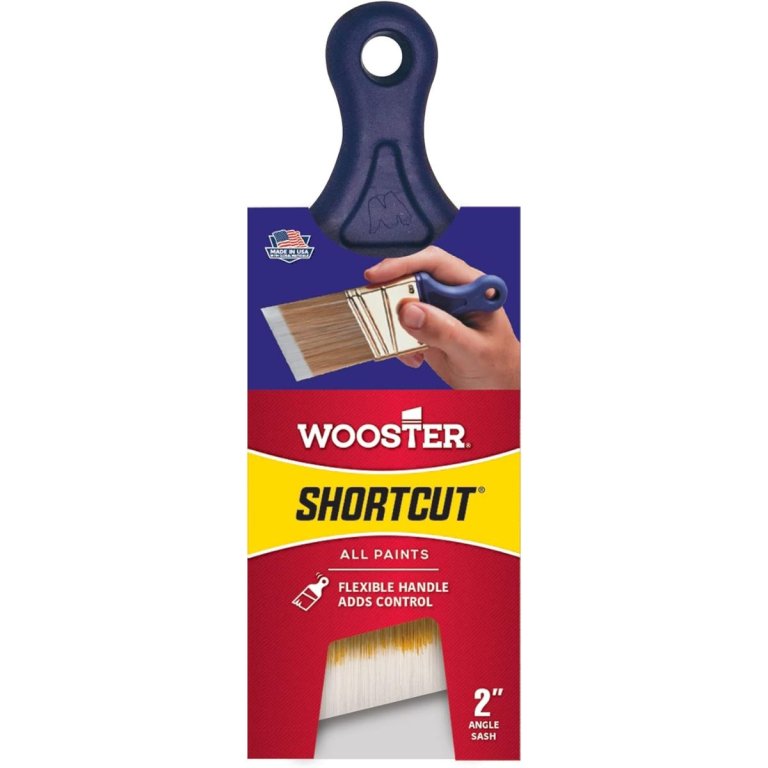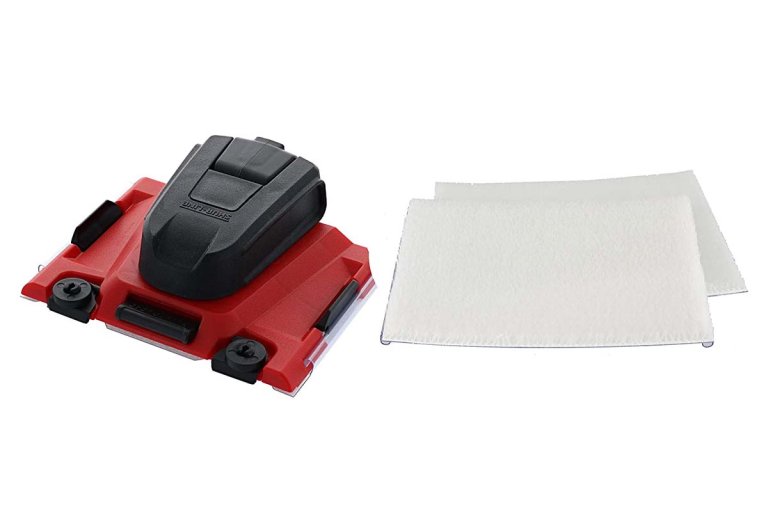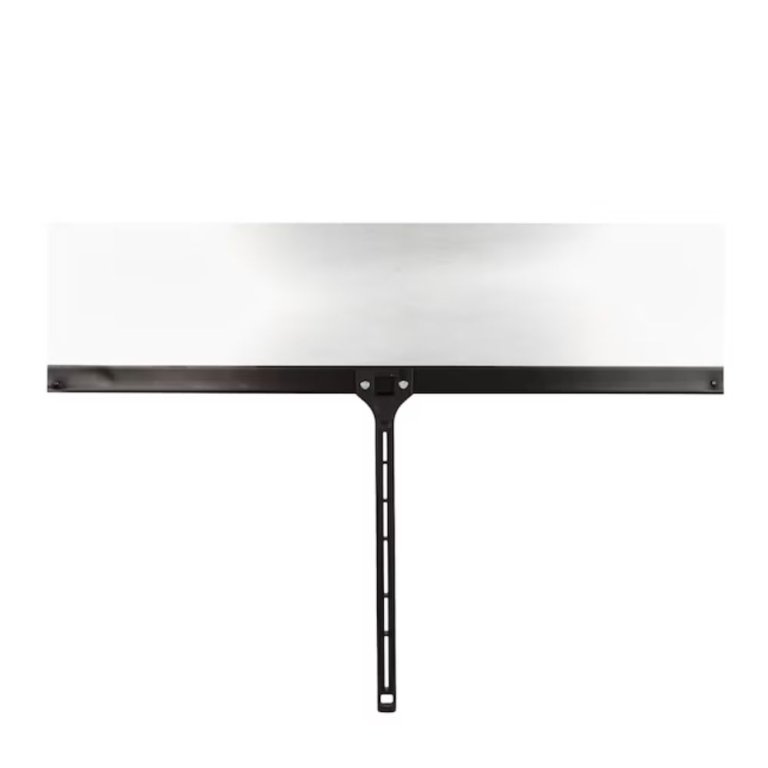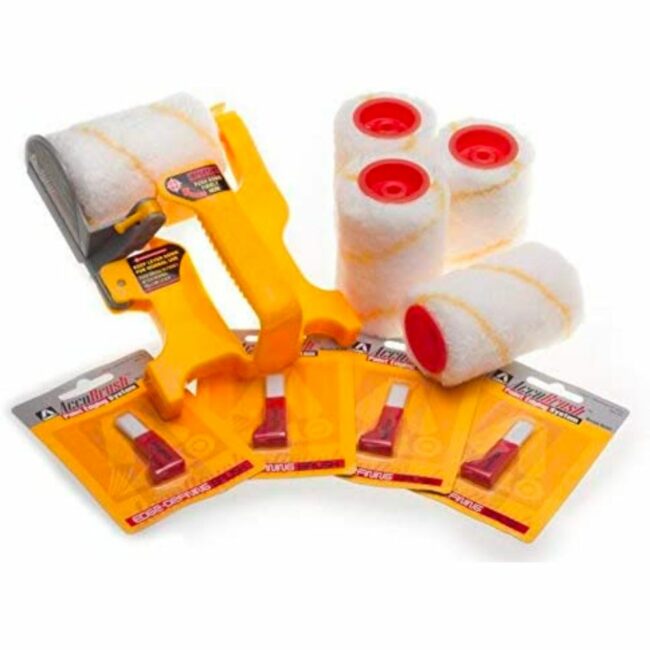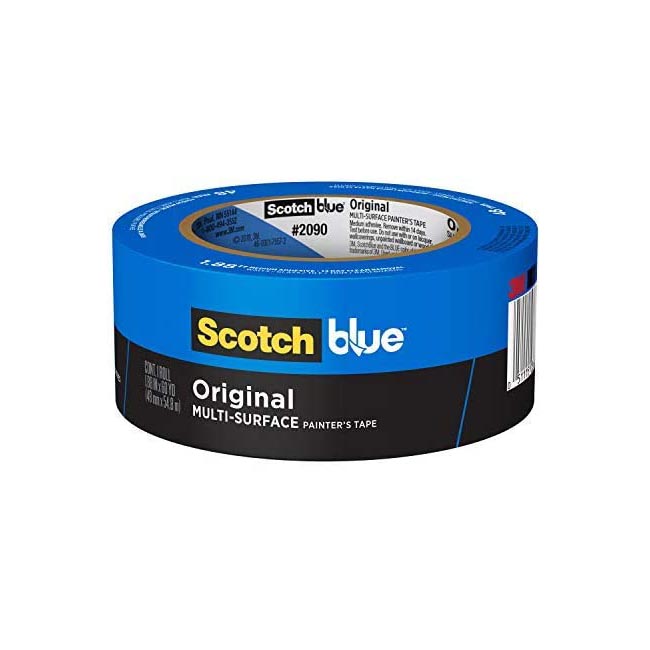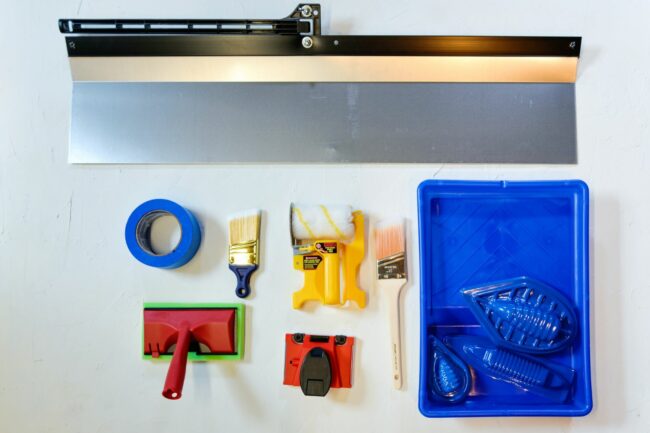
We may earn revenue from the products available on this page and participate in affiliate programs. Learn More ›
Paint edgers make it easy to create the crisp, clean edges that are the hallmark of a great paint job. They replace the need for painter’s tape by allowing you to paint directly up against ceilings, baseboards, and window and door trim with less risk of stray brushstrokes.
To see which paint tools for edging deliver the best results, we tested some of the most popular options on the market. Our top recommendation is the Pro Grade Supplies 2-Inch Angled Sash Paint Brush for its versatility, compatibility with oil- and water-based paints, and excellent performance across different edging tasks. Read on for key shopping considerations, detailed test results, and info on all of our picks for the best paint edgers.
- BEST OVERALL: Pro Grade Supplies 2-Inch Angled Sash Paint Brush
↓ Jump to Review - BEST BANG FOR THE BUCK: Wooster Brush Q3211 2-Inch Shortcut Angle Sash Brush
↓ Jump to Review - BEST PROFESSIONAL: Shur-Line 2006559 Edger Plus Premium Paint Edger
↓ Jump to Review - BEST FOR SPRAYING: Warner Tool 36-Inch Spray Shield
↓ Jump to Review - BEST EDGER KIT: Accubrush 11-Piece MX Jumbo Kit
↓ Jump to Review - BEST EDGING TAPE: ScotchBlue 2090 Original Multi-Surface Painter’s Tape
↓ Jump to Review
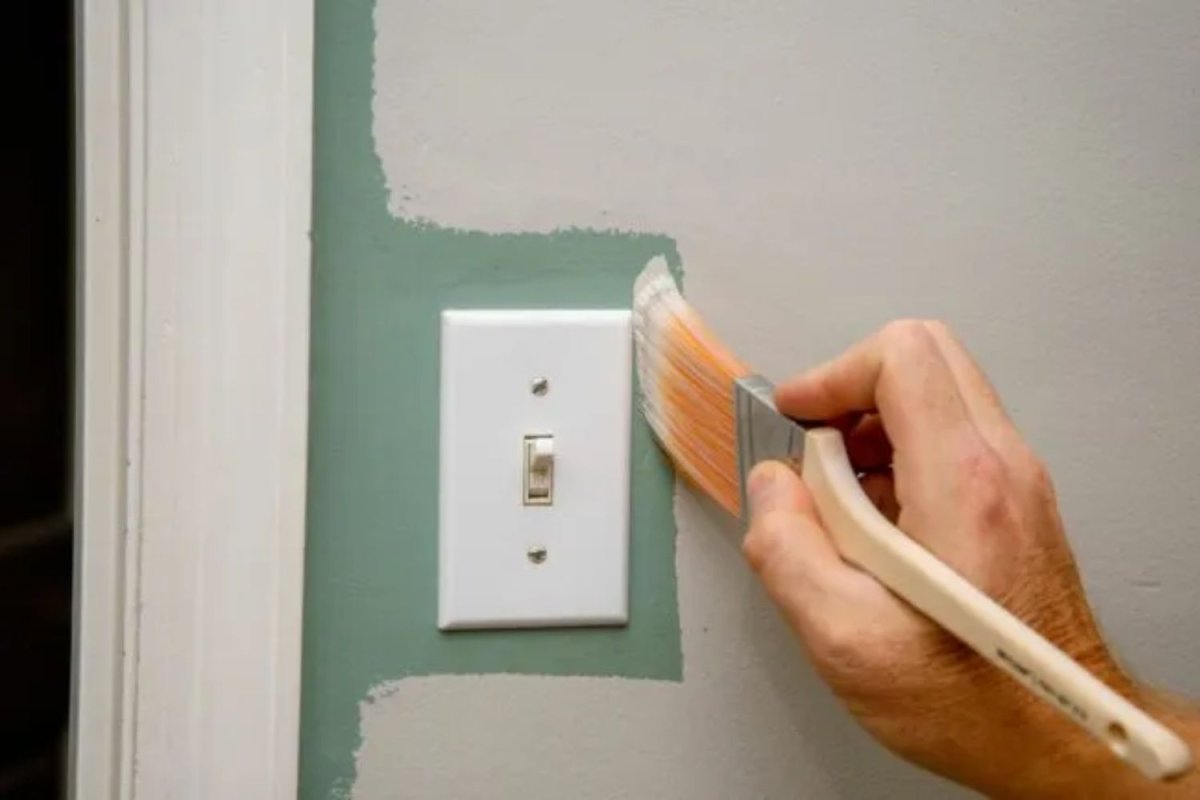
Paint Edgers Comparison
| Product | Edger Type | Width | Material |
|---|---|---|---|
| Pro Grade Supplies 2-Inch Angled Sash Paint Brush | Brush | 2 inches | Synthetic bristles, wood handle |
| Wooster Brush Q3211 2-Inch Shortcup Angle Sash Brush | Brush | 2 inches | Synthetic bristles, Shergrip handle |
| Shur-Line 2006559 Edger Plus Premium Paint Edger | Pad | 5.75 inches | Fabric head, plastic body |
| Warner Tool 36-Inch Alum Spray Shield | Shield | 36 inches | Aluminum |
| Accubrush 11-Piece MX Jumbo Kit | Roller with guard | 4 inches | Synthetic roller, plastic handle |
| ScotchBlue 2090 Original Multi-Surface Painter’s Tape | Tape | 1.88 inches | Paper and adhesive |
Our Top Picks
We reviewed each edger painting tool below for speed, comfort, and convenience. The right one can help you avoid a few of the painting mistakes almost everyone makes, like getting paint on the ceiling or thinking one brush is enough to handle every part of a project.
Best Overall
Photo: AmazonWhat We Like
- Works for a wide variety of edging projects
- Compatible with oil- and water-based paints and stains
- Bristles pick up and lay down a perfect amount of paint
- Long handle for extended reach
What We Don’t Like
- Bristles are too stiff for some applications
Product Specs
- Edger type: Brush
- Width: 2 inches
- Material: Synthetic bristles, wood handle
Our Ratings: Ease of Use 5/5; Performance 4.5/5; Comfort 5/5; Value 5/5
Because angled edges fit neatly into corners and produce cleaner, straighter lines than square-edge brushes, they’re often professional painters’ preferred choice for cleanly cutting in trim, whether working freehand or with a guide. At 2 inches wide, this version from Pro Grade Supplies is versatile for cutting in corners, painting trim, finishing furniture, and performing detail work. Its synthetic bristles are not only compatible with all sheens of water- and oil-based paints and stains, they also pick up and release the perfect amount of paint. Its 7.5-inch wood handle offers excellent reach and is slip-resistant and comfortable, even in hot, humid outdoor conditions.
In testing, this brush was a great tool for paint edging and trim projects. Although working without a guide required a steady hand, the shape, size, and bristle material made it easier to create straight lines with minimal mistakes. It also worked well on tight curves, like around the base of a doorknob, and the handle was comfortable in multiple grip positions.
What our tester says: “This is my go-to for cutting edges between walls and ceilings without painter’s tape. Even though I have to work a little bit slower to keep things clean, not using tape ends up saving me time and money in the long run.”—Mark Wolfe, Product Reviews tester and writer
Get the Pro Grade Supplies paint edger (various pack sizes) at Amazon or Pro Grade Supplies.
Best Bang For The Buck
Wooster Brush Q3211 2-Inch Shortcut Angle Sash Brush
Buy at Amazon Buy at Lowe's Buy at Ace HardwareWhat We Like
- Short, flexible handle is great for use in tight spaces
- Cushioned handle helps prevents fatigue during use
- Polyester bristles are compatible with most paints
What We Don’t Like
- Requires taping for some projects
- Purpose designed with a shorter reach
Product Specs
- Edger type: Brush
- Width: 2 inches
- Material: Synthetic bristles, Shergrip handle
Our Ratings: Ease of Use 4/5; Performance 4/5; Comfort 5/5; Value 4.5/5
Wooster Brush’s Shortcut trim brush offers excellent control and comfort for precision work, even during extended use. The unique grip has a flexible rubbery handle that rests like a pencil between your thumb and forefinger, allowing you to guide the brush by the ferrule. Its 2-inch angled head offers excellent paint pickup and precise application for most trim-painting tasks.
I’m already a big fan of using angled brushes to make straight lines, and this Wooster Shortcut made that process even easier. The short, cushioned handle improved responsiveness and was noticeably more comfortable and less fatiguing than hard plastic or wood handles. Its compact size also made it easy to work in tighter spaces. However, that small size also reduced its reach, which made using it as a high ceiling paint edger a bit of a slower process.
Best Professional
Shur-Line 2006559 Edger Plus Premium Paint Edger
Buy at AmazonWhat We Like
- Wheel spacers help maintain precision
- Handle is durable, comfortable, and easy to control
- 2 changeable fabric paint pads last a long time
What We Don’t Like
- Bristles hold less paint than other products
- Not ideal for textured surfaces or molded trim
Product Specs
- Edger type: Pad
- Width: 5.75 inches wide
- Material: Fabric pad, plastic handle
Our Ratings: Ease of Use 5/5; Performance 4/5; Comfort 5/5; Value 4.5/5
Pros who paint a host of different areas and use a variety of products may appreciate the Shur-Line Edger, a compact pad-style edger that helps you create crisp lines on baseboards and ceilings. It has a flexible swivel handle that makes it easy to maneuver in tight spaces and a built-in extender receiver that attaches to a paint pole (sold separately) for safer, less tiring work. It has two wheels along the front edge that act as spacers to keep it perfectly aligned during use, and these retractable guides stay clean even when a pad is fully loaded with paint.
In testing, the Shur-Line Edger proved to be a versatile, quality product. The plastic housing felt durable, and the changeable pads, which are well suited to gloss, semi-gloss, satin, eggshell, and flat interior paints, held up through multiple uses. Even when the pads were loaded with paint, the corner painting tool was comfortable to hold and easy to control. However, since the pads don’t have sponge backing, they didn’t hold as much paint as other edgers, making them better for flat, mostly smooth surfaces rather than deeply textured walls or molded trim.
Get the Shur-Line paint edger at Amazon.
Best For Spraying
Photo: Lowe’sWhat We Like
- Lightweight and easy to use
- 18-inch handle and 36-inch shield
- Handle folds for easy storage
What We Don’t Like
- Aluminum is capable of bending
- Excess overspray may run off onto the work area
Product Specs
- Edger type: Shield
- Width: 36 inches
- Material: Aluminum
Our Ratings: Ease of Use 4/5; Performance 4/5; Comfort 5/5; Value 4/5
The Warner Tool spray shield helps create straight, clean edges while rolling, smearing, and brushing paint, but it works best when paired with a sprayer. Its 36-inch-long by 9-inch-wide blade provides ample coverage for painting wide swaths, yet the aluminum shield is lightweight enough to minimize user fatigue. It comes with an 18-inch handle that provides an extended reach and then folds down for storage and transport.
In testing, the Warner spray shield saved us hours of taping and covering in preparation for spray painting. It was lightweight, simple to use in tandem with an airless spray gun, and easy to clean (overspray on the aluminum dries quickly and you just peel it off). While the adjustable handle was helpful, readjusting it from a fixed position took longer than expected. The shield also bent relatively easily at the corners, so you’ll want to be careful with handling and storage.
Get the Warner paint edger at Lowe’s or Amazon.
Best Edger Kit
Accubrush 11-Piece MX Jumbo Kit
Buy at AmazonWhat We Like
- Washable and reusable paint edger roller
- Comes with 5 roller covers and 5 brushes
- Great around door and window trim and baseboards
What We Don’t Like
- Only edges on the left side
- Low-nap roller cover only works on smooth walls
Product Specs
- Edger type: Roller with guard
- Width: 4 inches
- Material: Synthetic roller, plastic handle
Our Ratings: Ease of Use 5/5; Performance 4/5; Comfort 4/5; Value 4/5
The Accubrush MX painting tool is a unique device that combines a 4-inch roller with a hinged edge guide and a miniature following brush to reduce the time and hassle of paint edging. Sold as a kit, it comes with five roller heads and five mini brushes.
In testing, the Accubrush MX edger for painting was easy to use and quite effective for cutting in walls around window and door trim, baseboards, and crown molding. Though it also worked along the ceiling line, our textured ceiling caused the finished edge to be slightly less precise. Also, paint occasionally accumulated on the guide’s inner edge, meaning I had to wipe it off each time I loaded it. Still, this tool reduced edging time by at least half compared to brushing, even with a bit of final touch-up brushwork in the corners where the roller couldn’t reach.
Get the Accubrush paint edger at Amazon.
Best Edging Tape
ScotchBlue 2090 Original Multi-Surface Painter’s Tape
Buy at Amazon Buy at Ace Hardware Buy at The Home DepotWhat We Like
- Sticks on most surfaces but leaves no sticky residue
- Moisture- and UV-resistant
- Safe to leave in place for up to 14 days
What We Don’t Like
- Takes time to apply and remove
Product Specs
- Edger type: Tape
- Width: 1.88 inches
- Material: Paper and adhesive
Our Ratings: Ease of Use 5/5; Performance 5/5; Comfort 5/5; Value 5/5
Even with so many quality edging tools available, some jobs still turn out best with painter’s tape—and ScotchBlue is hard to beat when odd shapes or intricate patterns are involved. Its powerful but residue-free adhesive sticks to most materials, locking out paint from ruining the surface beneath. You can leave it in place for up to 14 days, and when your project is complete, the moisture- and UV-resistant tape is easy to take off.
ScotchBlue did well in testing both indoors and out. When painting a ceiling with a popcorn finish, it adhered firmly, produced a crisp edge, and came off without causing damage. Outdoors, I applied it to unfinished pressure-treated decking, waited 2 days, painted, and waited another 10 days. Even after being in place for nearly 2 weeks, no paint seeped underneath the tape, and it peeled away easily without messing anything up.
What our tester says: “ScotchBlue creates such consistently clean edges in so many different types of indoor and outdoor painting projects that it’s easy to recommend.”—Mark Wolfe, Product Reviews tester and writer
Get the ScotchBlue paint edger at Amazon, Ace Hardware, The Home Depot, or Target.
ALSO TESTED
I had high hopes for this Shur-Line 7-inch paint pad, which features a plastic frame with a replaceable low-nap pad and extender slot, but it proved hard to control along edges. Its broad, spongy surface and angled, rigid handle made it hard to see how close I was to trim, which meant I couldn’t create precise edges. To be fair, this pick is sold as an applicator rather than an edger, and it definitely worked best when applying a smooth coat of paint over a large area.
Jump to My Top Picks
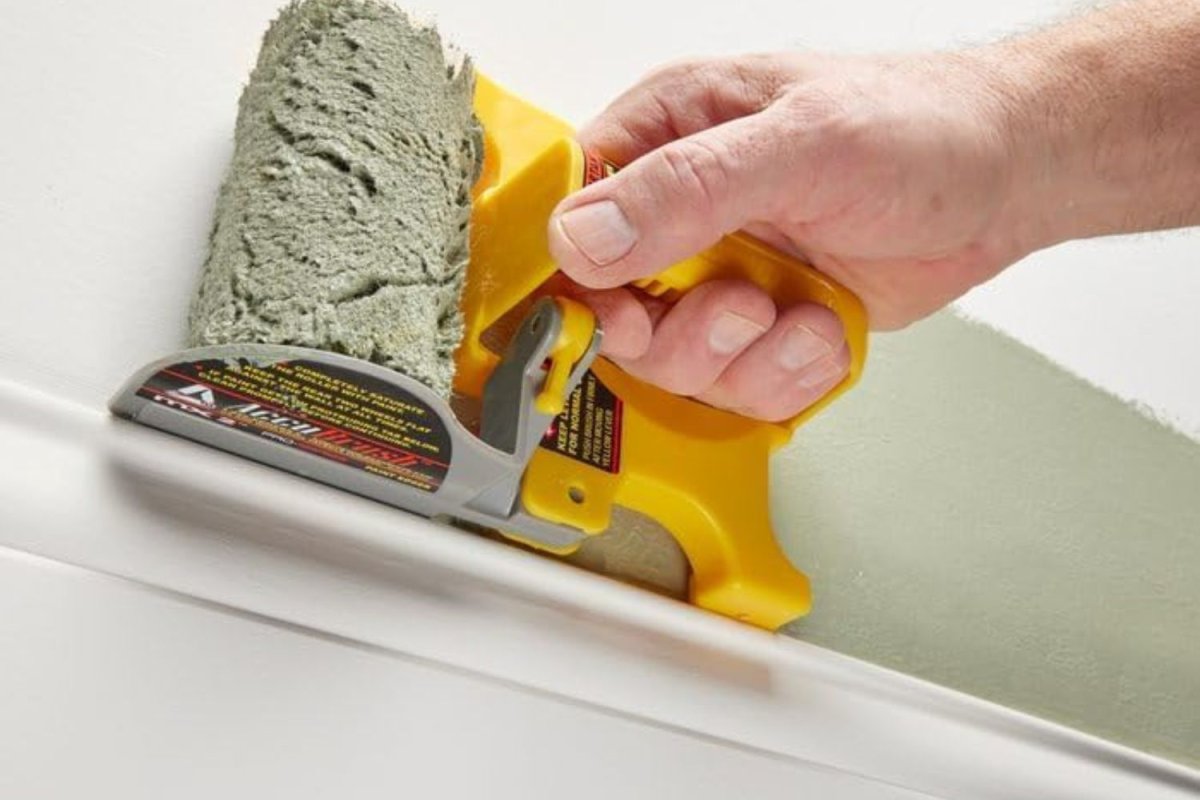
How We Tested the Best Paint Edgers
| Testing Stats | |
| Products tested | 8 |
| Time spent testing | 8 hours |
| Tests performed | 3 to 4 |
| Price range | $6 to $50 |
Ben Illig, a general contractor with decades of experience and owner of Illig Properties in Ebensburg, Pennsylvania, says the great thing about paint edgers is that “for a DIY painter, they’re a way to achieve sharp lines with little experience.” He recommends looking for “how easily the edger can be cleaned. If you have to take the tool apart to wash it, that slows down the production.” For that reason, ease of cleaning along with simple paint insertion were my top considerations when selecting products to test.
To evaluate each roll of tape, unique tool, or brush for painting edges, I converted an average bedroom into a paint-edger testing lab. Over 8 hours, I refined my techniques for how to use a paint edger by using them to cut along 10-foot lengths of wall-ceiling lines, inner-wall corners, window and door trim, and baseboard trim. I then rated the tools for ease of use, quality of performance, comfort, and value, and assigned worthy tools awards based on their strengths.
| Product | Ease of Use | Performance | Comfort | Value |
| Pro Grade Supplies 2-Inch Angled Sash Paint Brush | 5 | 4.5 | 5 | 5 |
| Wooster Brush Q3211 2-Inch Shortcup Angle Sash Brush | 4 | 4 | 5 | 4.5 |
| Shur-Line 2006559 Edger Plus Premium Paint Edger | 5 | 4 | 5 | 4.5 |
| Warner Tool 36-Inch Alum Spray Shield | 4 | 4 | 5 | 4 |
| Accubrush 11-Piece MX Jumbo Kit | 5 | 4 | 4 | 4 |
| ScotchBlue 2090 Original Multi-Surface Painter’s Tape | 5 | 5 | 5 | 5 |
What to Consider When Choosing a Paint Edger
Paint edgers come in different sizes, shapes, materials, and configurations and work in slightly different ways. Ahead, learn about the different types of edgers and why one may be a better fit for your project than another.
Size
Paint edgers create a buffer that keeps the paint brush or roller from coming too close to the ceiling or trim. An edger can either be a special paint brush, pad, or roller designed with an attached guard or a separate guard you can use with a conventional paint brush, pad, or roller.
In the first instance, the guard comes connected to the implement that is applying paint. Because the guard moves with the painting tool, the most important thing to figure out is how wide the paint strip should be. If it is a simple wall with only baseboard trim and a ceiling to protect, a wider paint strip is in order. If painting narrow areas, such as between closely spaced windows or behind a door near a corner, a smaller edger that will fit into these tight spaces will be necessary.
Material
Regardless of the type of edger chosen, it is important to pick an applicator whose material is appropriate for the type of paint. Oil-based paints and stains work with brush and roller-type edgers that have natural bristles or natural fiber covers. Use a brush or roller cover made with synthetic materials for water-based latex and acrylic paints. Paint pads may be used for either oil-based or water-based paints.
Roll-On vs. Smear-On
A roll-on edger is a small paint roller that has a flocked cover for smooth paint application and a shield on one side to keep the paint away from the wall or other surface. Roll-on edgers work in much the same way as regular paint rollers.
Smear-on edgers use an absorbent pad to apply the paint. Sometimes you simply dip them into paint, and other times they have onboard paint reservoirs, often inside the handle. Those with a paint reservoir can apply 50 linear feet (or more) per load, while the dip-in types only hold enough paint to cover a few linear feet.
Brush vs. Pad
Paint edgers with pads use the smear method to apply paint. They are made of an absorbent material that works like a sponge to soak up paint from the tray and have a textured surface that lays down a clean finish. Pads are designed to apply a smooth, even, full coat in a single pass.
Brush-type edgers work like regular paint brushes. They hold less paint than pads, so it takes longer to paint a similarly sized space. The guard on a brush edger cannot maintain as crisp a line as that on a pad because the bristles need to move in order to release the paint. Brush edgers are often a better choice than pad edgers when painting a textured surface.
Extender
An extender is an accessory that may prove very helpful when painting rooms, as it reduces reaching, bending, squatting, and kneeling to access both high and low spots. By using an edger with a pole extender, the painter can stand on the ground and safely reach the top of a high wall to cut in at the ceiling line—as opposed to climbing a ladder and risking a fall. Painting rooms with high ceilings is often easier with an extender because it gives the painter a greater range with less actual motion.
Extenders come in a variety of lengths, both fixed and adjustable. They are made with a universal fit to thread into the receiving ends of all compatible paint edgers and paint rollers.
The Advantages of Owning a Paint Edger
The sole function of a paint edger is to make straight, clean lines. While many folks balk at the idea of purchasing a tool that only does one thing, its benefits far outweigh its reasonable cost. This type of tool typically pays for itself by eliminating the cost of painter’s tape and any labor costs associated with taping edges before painting and removing tape when the job is done.
- Paint edgers are easy to use and leave a crisp, clean edge.
- They save on material and labor costs because there’s no need to buy, apply, and remove painter’s tape.
- Pad edgers and roller edgers apply paint faster and cleaner than cutting in with a standard paint brush.
FAQs
If you still have a few questions about painting with an edger, you aren’t alone. Read on for answers to frequently asked questions about what these tools can do.
A paint edger is a tool that applies paint with a straight, clean line at the outer edges, inner corners, or along trim work. Edgers eliminate the need to tape along connected walls or trim or worry about whether you’re steady-handed enough to cut in with a paint brush.A paint edger is a tool that applies paint with a straight, clean line at the outer edges, inner corners, or along trim work. With an edger, you may not need to tape along trim molding or ceilings, nor do you have to cut in with a paint brush.
No, a paint edger is not necessary for painting work. It is, however, an upgrade over the traditional method of taping ceiling, baseboard, window, and door edges and cutting in with a paint brush.
The best way to paint edges is with a paint edger or a brush after taping. Paint-pad edgers offer the speed of a paint roller and the accuracy of a brush without the added time and expense of using painter’s tape. Taping and brushing may offer better results in some situations, such as on intricate or oddly shaped areas.
No, it’s generally not recommended to edge one day and paint the next, as doing so can create visible lines. Edging and painting within the same day is ideal to create the smoothest finish possible.
Yes, paint edgers actually work, especially for those with less painting experience. While pros may be able to use a paint brush to create a precision line, edgers can make the process easier for beginners, allowing them to create clean, sharp edges quickly.
Generally speaking, you’ll want to clean and maintain your paint edger by immediately rinsing it with warm, soapy water if using latex paint or mineral spirits if using oil-based paint. Remove as much paint as possible and let air dry fully before storage.
Meet the Tester
Mark Wolfe is a writer with an extensive background in the green industry and an avid DIYer who lives in a 50-year-old home. When he isn’t writing, he spends his time upgrading, repairing, and replacing anything and everything in his home, yard, and garden. He tests and writes reviews about hand tools, lawn care and home repair products, and outdoor living goods.
